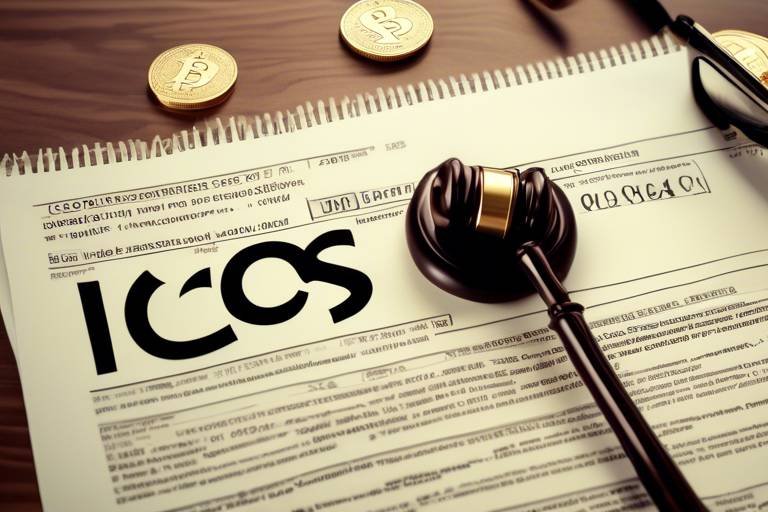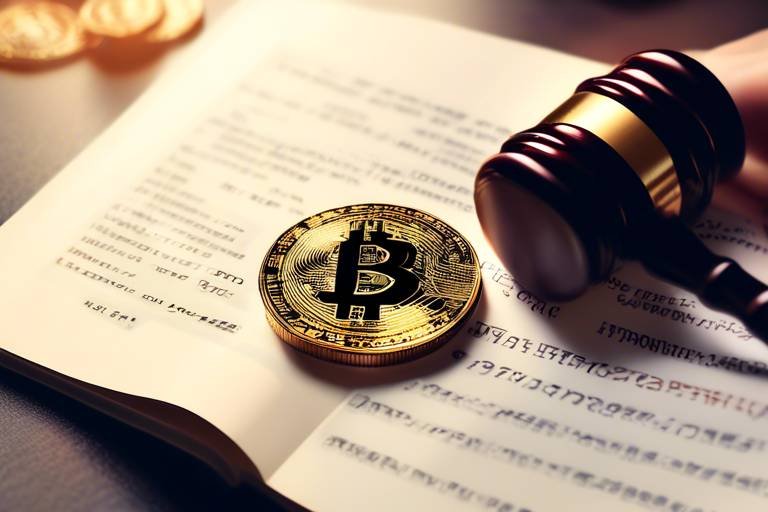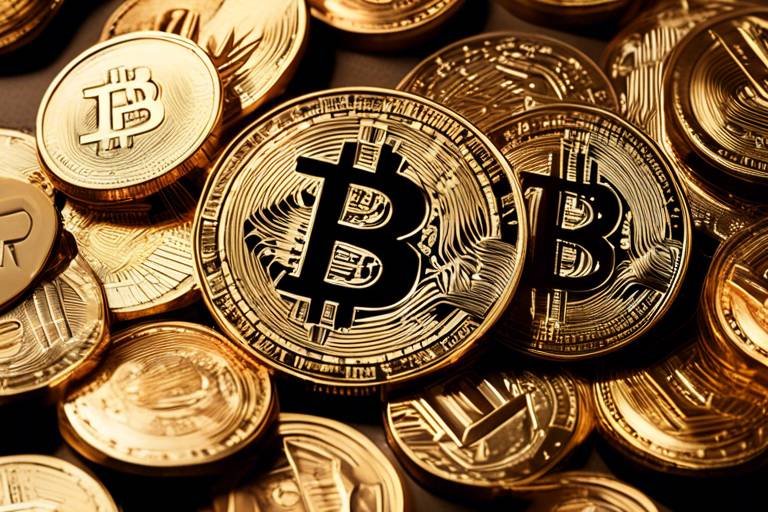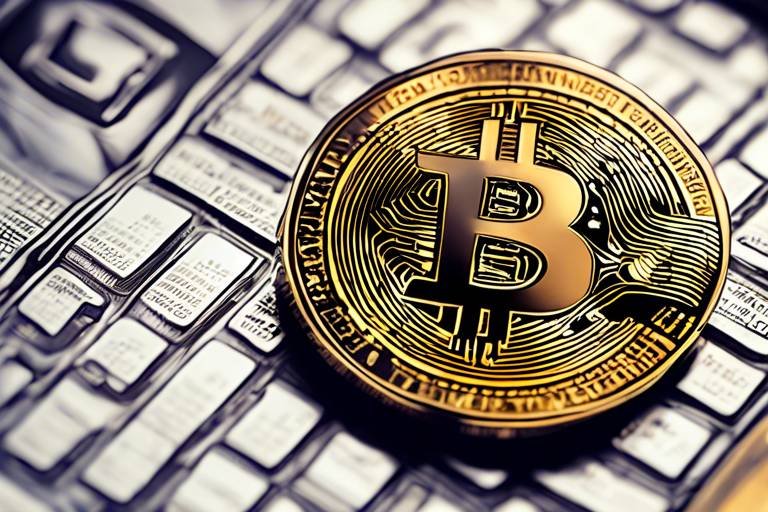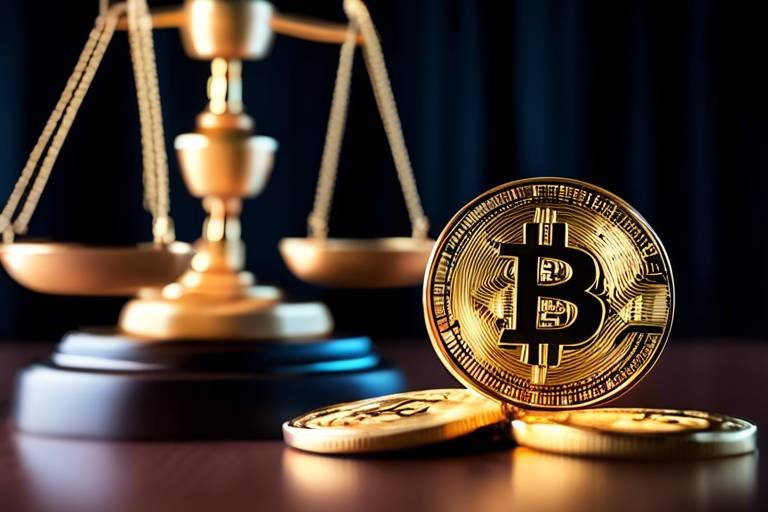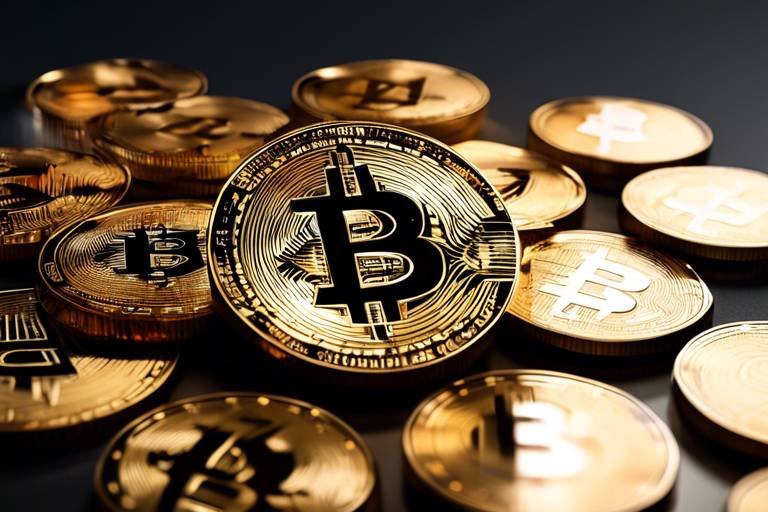How to Navigate Legal Issues in Decentralized Finance (DeFi)
Decentralized Finance, commonly referred to as DeFi, is revolutionizing the way we think about financial systems. Unlike traditional finance, which is often bound by bureaucratic regulations and centralized authorities, DeFi operates on a decentralized network, primarily using blockchain technology. This radical shift opens up a world of opportunities, but it also introduces a complex legal landscape that participants must navigate carefully. In this article, we will explore the intricate web of legal issues surrounding DeFi, focusing on regulatory challenges, compliance strategies, and the potential legal frameworks that can guide users through this innovative financial ecosystem.
At its core, DeFi is about removing intermediaries from financial transactions, allowing users to engage directly with one another. This is achieved through smart contracts—self-executing contracts with the terms of the agreement directly written into code. Imagine a world where you can lend, borrow, and trade assets without the need for a bank or broker. Sounds liberating, right? However, this newfound freedom comes with its own set of challenges. With great power comes great responsibility, and understanding the fundamental principles of DeFi is essential for both users and regulators alike.
The rapid growth of the DeFi sector presents unique regulatory challenges that can feel like navigating a minefield. As DeFi platforms gain popularity, they often find themselves at odds with existing financial regulations. Regulators are scrambling to keep up with the pace of innovation, which can lead to inconsistent enforcement and confusion among users. So, what are these hurdles, and how do they impact innovation and user protection in the DeFi space?
Various regulatory bodies oversee financial activities across different jurisdictions. These organizations, such as the U.S. Securities and Exchange Commission (SEC) and the Financial Action Task Force (FATF), play a crucial role in enforcing compliance. Their guidelines can heavily influence DeFi operations, often leading to a tug-of-war between innovation and regulation. Understanding the roles of these bodies is essential for any DeFi project aiming to thrive in a compliant manner.
DeFi operates on a global scale, which means that participants must be aware of international regulations. Different countries have different approaches to DeFi, and understanding these can be the key to success. For instance, while some jurisdictions may embrace DeFi with open arms, others may impose strict regulations that could stifle innovation. Here are a few examples of international regulations that impact DeFi:
| Country | Regulation Type | Impact on DeFi |
|---|---|---|
| United States | Securities Regulation | Potential classification of tokens as securities |
| European Union | MiCA Regulation | Framework for crypto-assets |
| China | Ban on Crypto Transactions | Severe restrictions on DeFi operations |
Each country has its own regulatory framework that can significantly impact DeFi projects. For example, in the U.S., the SEC has been increasingly scrutinizing DeFi offerings, which can create uncertainty for developers. In contrast, countries like El Salvador have embraced cryptocurrencies, creating a more favorable environment for DeFi projects. Understanding the specific regulations in your jurisdiction is crucial for compliance and operational success.
Ensuring compliance is not just a legal obligation; it’s also a smart business strategy. DeFi projects can adopt several effective strategies to align with existing regulations while still fostering innovation. These may include:
- Conducting thorough legal audits to assess compliance risks.
- Implementing robust KYC (Know Your Customer) and AML (Anti-Money Laundering) procedures.
- Engaging with legal experts to stay updated on regulatory changes.
By adopting these strategies, DeFi projects can navigate the legal landscape more effectively, minimizing risks while maximizing their potential for growth.
Despite the exciting opportunities that DeFi presents, it is not without its legal risks. From liability issues to intellectual property concerns, participants must be vigilant. Understanding these risks is essential for anyone looking to engage in DeFi.
Smart contracts are the backbone of DeFi, but they can also be a double-edged sword. Vulnerabilities in smart contracts can lead to significant financial losses and legal repercussions. It’s essential to conduct regular audits and employ best practices in coding to mitigate these risks. Imagine a poorly written smart contract as a leaky faucet; if not fixed, it could lead to a flood of problems.
In the event of conflicts, having effective dispute resolution mechanisms in place is crucial. Traditional legal systems may not always be equipped to handle the unique challenges posed by DeFi. Exploring alternative dispute resolution methods, such as arbitration or mediation, can provide a more efficient way to resolve issues without resorting to lengthy court battles.
As DeFi continues to evolve, so too will its regulatory landscape. The future may hold more cohesive legal frameworks that can provide clarity and protection for users while still fostering innovation. It’s essential for participants to stay informed and adaptable, as the legal landscape is likely to change rapidly in response to technological advancements and market dynamics.
- What is DeFi? DeFi stands for decentralized finance, which refers to financial services that operate on blockchain technology without intermediaries.
- What are the main legal risks in DeFi? Legal risks include regulatory compliance issues, smart contract vulnerabilities, and disputes among users.
- How can DeFi projects ensure compliance? By conducting legal audits, implementing KYC/AML procedures, and staying updated on regulatory changes.

Understanding Decentralized Finance
Decentralized finance, or DeFi, is revolutionizing the way we think about money and financial systems. Imagine a world where you don't need a bank to manage your finances—where you can lend, borrow, and trade assets directly with others. That’s the essence of DeFi! Built on blockchain technology, DeFi eliminates intermediaries, allowing users to engage in financial activities directly with one another. This innovative approach not only enhances accessibility but also fosters a sense of ownership and empowerment among users.
At its core, DeFi operates on the principles of transparency, security, and inclusivity. Thanks to smart contracts—self-executing contracts with the terms of the agreement directly written into code—transactions are executed automatically when conditions are met. This reduces the risk of fraud and ensures that all parties are held accountable. But what does this mean for the average user? Well, it means you can lend your assets to earn interest, trade cryptocurrencies without hefty fees, and even create your own financial products, all from the comfort of your home.
However, with great power comes great responsibility. As DeFi grows, so do the complexities surrounding it. Users must navigate a landscape filled with both opportunities and challenges. For instance, while DeFi platforms offer higher returns than traditional banks, they also come with risks, such as smart contract vulnerabilities and market volatility. Therefore, understanding the foundational principles of DeFi is crucial for anyone looking to participate in this new financial ecosystem.
To fully grasp the implications of DeFi, it's essential to recognize its key components:
- Decentralization: Unlike traditional finance, where a central authority controls transactions, DeFi operates on a peer-to-peer basis.
- Interoperability: DeFi protocols are designed to work together, allowing users to move assets seamlessly across different platforms.
- Open Access: Anyone with an internet connection can participate, breaking down barriers that often exist in traditional finance.
In summary, DeFi is not just a trend; it's a paradigm shift that has the potential to redefine the financial landscape as we know it. As we delve deeper into the complexities of this ecosystem, understanding its principles will empower users to make informed decisions and navigate the challenges ahead.

Regulatory Challenges in DeFi
Decentralized Finance, or DeFi, has emerged as a revolutionary force in the financial world, but it doesn't come without its fair share of challenges, particularly in the realm of regulation. As the DeFi landscape expands rapidly, regulators find themselves grappling with how to effectively oversee this innovative sector. The unique nature of DeFi—characterized by its reliance on blockchain technology and smart contracts—creates complexities that traditional financial regulations often fail to address.
One of the primary hurdles is the anonymity and decentralization inherent in DeFi platforms. Unlike traditional financial institutions, which have clear lines of accountability, DeFi operates without a central authority. This raises questions about who is responsible when things go wrong. For instance, if a smart contract is exploited, who bears the liability? Is it the developers, the users, or the platform itself? These questions complicate the regulatory landscape and create uncertainty for participants.
Furthermore, the rapid pace of innovation in DeFi often outstrips the ability of regulators to keep up. By the time a regulatory framework is proposed, it can feel outdated, as new technologies and methodologies are already emerging. This lag can stifle innovation, as developers may hesitate to launch new projects due to fear of regulatory repercussions.
Additionally, the global nature of DeFi means that participants are often subject to multiple jurisdictions, each with its own set of rules and regulations. The lack of a cohesive regulatory framework can lead to confusion and inconsistent compliance requirements. For instance, a DeFi project that operates in both the United States and the European Union may find itself navigating a complex web of regulations that differ significantly from one region to another.
To illustrate these challenges, consider the following table that summarizes key regulatory concerns faced by DeFi projects:
| Regulatory Concern | Description |
|---|---|
| Liability | Determining who is responsible for losses due to smart contract failures. |
| Compliance | Navigating different regulations across jurisdictions. |
| Consumer Protection | Ensuring users are safeguarded against fraud and exploitation. |
| Taxation | Understanding tax obligations for transactions conducted on DeFi platforms. |
In light of these challenges, it's crucial for DeFi participants to stay informed and proactive. Developers should consider implementing robust compliance measures and engage with legal experts to navigate the regulatory landscape effectively. By doing so, they not only protect their projects but also contribute to the overall legitimacy and sustainability of the DeFi ecosystem.
As the DeFi space continues to evolve, the dialogue between regulators and industry participants will be essential in shaping a regulatory framework that fosters innovation while protecting users. It’s a balancing act that requires collaboration, understanding, and a willingness to adapt to the changing tides of technology and finance.

Key Regulatory Bodies
When it comes to navigating the complex waters of decentralized finance (DeFi), understanding the role of key regulatory bodies is crucial. These organizations act as the gatekeepers of financial integrity, ensuring that participants play by the rules. Think of them as the referees in a game where the stakes are incredibly high, and the players are constantly innovating. The regulatory landscape is not just a set of rules; it's a framework that can either foster innovation or stifle it, depending on how it's implemented.
Among the most prominent regulatory bodies are:
- U.S. Securities and Exchange Commission (SEC): This body oversees securities transactions and has been increasingly scrutinizing DeFi projects to determine whether they fall under its jurisdiction.
- Commodity Futures Trading Commission (CFTC): The CFTC focuses on the regulation of commodity futures and options markets, which can intersect with DeFi platforms that offer derivatives.
- Financial Action Task Force (FATF): An intergovernmental organization that sets standards for combating money laundering and terrorist financing, the FATF has issued guidelines that influence how DeFi projects operate globally.
- European Securities and Markets Authority (ESMA): In Europe, this agency plays a vital role in ensuring investor protection and market stability, particularly as DeFi gains traction in the region.
Each of these bodies has its own set of guidelines and enforcement mechanisms that can significantly impact how DeFi platforms operate. For instance, the SEC's stance on whether a cryptocurrency is classified as a security can determine the legal obligations of a DeFi project. Similarly, the CFTC's focus on derivatives might lead to new compliance requirements for platforms offering futures or options.
Moreover, the regulatory landscape is not static; it evolves as technology and market dynamics change. This constant evolution means that DeFi participants must stay informed about the latest regulatory developments. Ignoring these changes can lead to serious legal repercussions, including fines or even the shutdown of a project. Therefore, understanding the roles and responsibilities of these regulatory bodies is not just beneficial—it's essential for anyone involved in the DeFi ecosystem.
As the DeFi space continues to grow, so too does the need for clear communication between developers and regulators. Establishing a dialogue can help create a more cohesive regulatory framework that balances innovation with consumer protection. After all, a well-regulated DeFi environment can lead to greater trust among users, ultimately benefiting the entire ecosystem.

International Regulations
When it comes to decentralized finance (DeFi), one of the most intriguing aspects is its global nature. Unlike traditional finance, which is often confined within national borders, DeFi operates on a worldwide scale, creating a patchwork of regulatory challenges. Each country has its own approach to financial regulation, and understanding these differences is crucial for anyone looking to participate in the DeFi ecosystem. But why does this matter? Well, navigating through various international regulations can be like trying to find your way through a maze without a map. It’s not just about knowing the rules; it’s about understanding how they interact and impact your activities in the DeFi space.
In regions such as the European Union, regulators are increasingly focusing on creating comprehensive frameworks that address the unique challenges posed by DeFi. For instance, the Markets in Crypto-Assets (MiCA) regulation aims to provide a unified approach to cryptocurrency regulation across member states. This regulation seeks not only to protect consumers but also to foster innovation within the blockchain space. On the other hand, countries like China have taken a much stricter stance, imposing outright bans on cryptocurrency trading and Initial Coin Offerings (ICOs). Such contrasting regulations can create confusion and uncertainty for DeFi participants.
In the United States, the regulatory landscape is equally complex. Different states have varying laws governing cryptocurrency and DeFi activities. While some states, like Wyoming, are embracing DeFi and blockchain technology by creating favorable laws, others are more cautious, leading to a fragmented regulatory environment. This inconsistency can impact how DeFi projects operate, as they must navigate a myriad of state laws in addition to federal regulations.
To illustrate the differences in international regulations, consider the following table that summarizes key regulatory approaches in various regions:
| Region | Regulatory Approach | Key Regulations |
|---|---|---|
| European Union | Comprehensive Framework | MiCA, AMLD5 |
| United States | Fragmented State and Federal Laws | SEC Regulations, State Laws |
| China | Restrictive | Ban on ICOs, Cryptocurrency Trading |
| Singapore | Proactive and Supportive | Payment Services Act |
As the DeFi space continues to expand, it’s essential for participants to stay informed about the evolving international regulations. Engaging with local legal experts and staying updated on regulatory changes can help mitigate risks associated with non-compliance. After all, operating in a legally ambiguous environment can lead to significant repercussions, including fines or even the shutdown of projects. So, whether you're a developer, investor, or user, understanding international regulations isn't just a good idea—it's a necessity.

National Regulations
When it comes to decentralized finance (DeFi), understanding is like navigating a maze. Each country has its own set of rules that can significantly impact how DeFi projects operate within their borders. These regulations are not just bureaucratic red tape; they can shape the very foundation of how financial services are delivered in a decentralized manner. For instance, some nations may embrace DeFi wholeheartedly, providing a nurturing environment for innovation, while others may impose strict regulations that could stifle growth and creativity.
In the United States, regulatory bodies like the Securities and Exchange Commission (SEC) and the Commodity Futures Trading Commission (CFTC) have been vocal about their oversight of DeFi projects. They often classify tokens as securities, which means that any project offering these tokens must comply with the same regulations as traditional securities. This can create a challenging landscape for developers who want to offer innovative financial solutions without running afoul of the law. Similarly, in the European Union, the Markets in Crypto-Assets (MiCA) regulation aims to create a comprehensive regulatory framework for crypto-assets, including DeFi, which could either facilitate or hinder the growth of DeFi projects depending on how it's implemented.
However, it's not just about compliance; understanding national regulations can also offer opportunities. For example, countries like Switzerland and Singapore have established themselves as hubs for blockchain innovation due to their favorable regulatory environments. These nations have created clear guidelines that allow DeFi projects to flourish while ensuring consumer protection and financial stability. In contrast, countries that impose heavy restrictions may find themselves lagging behind in the DeFi race, as entrepreneurs seek more welcoming jurisdictions for their projects.
Moreover, the impact of national regulations extends beyond just compliance. It can influence investment decisions, partnerships, and even the overall viability of a DeFi project. For instance, if a project is deemed non-compliant in a particular country, it may lose access to a significant market, which could hinder its growth. Therefore, it is imperative for DeFi participants to stay informed about the regulatory landscape in their respective countries and be prepared to adapt to changes as they arise.
To summarize, the national regulatory framework surrounding DeFi is complex and ever-changing. It is essential for developers and users alike to keep an eye on these regulations, as they can have profound implications for the future of decentralized finance. As the DeFi ecosystem continues to grow, staying informed and compliant will be key to navigating this innovative financial landscape.
- What are the primary national regulations affecting DeFi?
National regulations vary widely, but key areas include securities laws, anti-money laundering (AML) requirements, and consumer protection laws. - How can DeFi projects ensure compliance?
DeFi projects should consult legal experts familiar with local regulations, conduct thorough compliance audits, and implement best practices for transparency and security. - Are there countries that are more favorable to DeFi?
Yes, countries like Switzerland and Singapore have established favorable regulatory environments that encourage DeFi innovation. - What happens if a DeFi project is found non-compliant?
Non-compliance can result in hefty fines, legal action, and the potential shutdown of the project, along with reputational damage.

Compliance Strategies for DeFi Projects
As the world of decentralized finance (DeFi) continues to expand, compliance has become a buzzword that every project must take seriously. Navigating the regulatory landscape is like walking a tightrope; one misstep can lead to significant legal repercussions. Therefore, it’s essential for DeFi projects to adopt robust compliance strategies that not only align with existing regulations but also promote innovation and trust among users.
First and foremost, understanding the regulatory environment is crucial. DeFi projects should invest time in researching the specific regulations that apply to their operations. This involves keeping abreast of the latest developments from various regulatory bodies, as these can change rapidly. For instance, regulations concerning anti-money laundering (AML) and know your customer (KYC) requirements are pivotal. By implementing thorough KYC processes, projects can verify the identities of their users, thereby reducing the risk of illicit activities.
Moreover, collaborating with legal experts who specialize in blockchain technology can provide invaluable insights. These professionals can help navigate the complexities of compliance, ensuring that projects are not only legally sound but also strategically positioned for growth. It’s like having a seasoned navigator on a ship; they help steer the course through turbulent waters of regulation.
Another effective strategy is to develop transparent governance frameworks. Transparency builds trust, which is vital in the DeFi space. By clearly outlining governance structures, decision-making processes, and how user feedback is incorporated, projects can foster a sense of community and ownership among their users. This not only aids in compliance but also encourages user engagement and loyalty.
Furthermore, regular audits and assessments should be part of a DeFi project’s compliance strategy. Engaging third-party auditors to review smart contracts and operational practices can identify potential vulnerabilities before they become major issues. This proactive approach is akin to having a health check-up; it helps catch problems early on, ensuring the project remains in good standing with regulators.
Lastly, it’s vital for DeFi projects to stay adaptable. The regulatory landscape is constantly evolving, and what works today may not be effective tomorrow. By fostering a culture of compliance that prioritizes flexibility and responsiveness, projects can better navigate the changing tides of regulation. This adaptability can be a significant competitive advantage, allowing them to pivot quickly in response to new legal requirements.
In summary, compliance in DeFi is not just about ticking boxes; it’s about creating a sustainable and trustworthy ecosystem. By understanding the regulatory landscape, collaborating with legal experts, developing transparent governance, conducting regular audits, and staying adaptable, DeFi projects can thrive in this innovative financial space while minimizing legal risks.
- What are the main compliance challenges faced by DeFi projects? DeFi projects often grapple with KYC/AML regulations, ensuring security against hacks, and navigating various international laws.
- How can DeFi projects ensure user data privacy while complying with regulations? Implementing privacy-preserving technologies and transparent data management practices can help balance compliance with user privacy.
- Why is legal consultation important for DeFi projects? Legal experts can provide tailored advice on navigating complex regulations, helping projects avoid costly mistakes.
- What role do audits play in compliance? Regular audits help identify vulnerabilities and ensure that smart contracts and operational practices align with regulatory standards.

Legal Risks in DeFi
Decentralized Finance (DeFi) has taken the financial world by storm, offering unprecedented opportunities for innovation and accessibility. However, with great innovation comes great responsibility, and the legal risks associated with DeFi are significant. Understanding these risks is crucial for anyone involved in the DeFi space, whether you are a developer, an investor, or a user. The legal landscape can be likened to a dense forest filled with both exciting opportunities and lurking dangers. Navigating this forest requires a keen awareness of potential pitfalls.
One of the primary legal risks in DeFi is liability. In traditional finance, liability is often clearly defined, but in the DeFi ecosystem, the lines can blur. Who is held accountable if a smart contract fails or if a user loses funds due to a bug? The decentralized nature of DeFi complicates this issue, as it can be challenging to pinpoint responsibility. Developers may argue that users should perform their due diligence, while users may claim that they relied on the platform's assurances. This ambiguity can lead to disputes and potential legal action.
Another significant risk involves intellectual property (IP). In an environment where code is often open-sourced, protecting intellectual property rights becomes a complex issue. Developers may inadvertently infringe on existing patents or copyrights, leading to legal battles that can drain resources and stifle innovation. Additionally, the lack of clear IP regulations in the DeFi space can create a fertile ground for disputes over ownership and usage rights.
Moreover, smart contracts, the backbone of DeFi, are not immune to vulnerabilities. These self-executing contracts can contain bugs or flaws that can be exploited by malicious actors. When these vulnerabilities are exploited, the legal implications can be severe. For instance, if a hacker drains funds from a DeFi protocol due to a smart contract flaw, who is responsible for the loss? The developers? The users? This uncertainty can lead to lengthy legal disputes and a loss of trust in the platform.
To mitigate these risks, it is essential for DeFi projects to implement robust security measures. Regular audits of smart contracts, thorough testing, and employing best practices in coding can significantly reduce the likelihood of vulnerabilities. Additionally, having clear terms of service and user agreements can help define liability and protect against potential legal claims. Transparency is key; users should be made aware of the risks involved in using DeFi platforms.
In the event of conflicts, effective dispute resolution mechanisms are vital. Traditional methods may not always apply in the DeFi space, so exploring alternative solutions such as decentralized arbitration platforms can be beneficial. These platforms can provide a fair and efficient way to resolve disputes without resorting to lengthy court battles.
In conclusion, while DeFi offers exciting opportunities, it is essential to remain vigilant about the legal risks involved. By understanding these risks and implementing effective strategies, participants can navigate the complex legal landscape of DeFi and contribute to a more secure and compliant ecosystem.
- What are the main legal risks associated with DeFi? The main legal risks include liability issues, intellectual property disputes, vulnerabilities in smart contracts, and challenges in dispute resolution.
- How can DeFi projects mitigate legal risks? Projects can mitigate risks by implementing robust security measures, conducting regular audits, and establishing clear terms of service.
- What should users know before engaging with DeFi platforms? Users should be aware of the potential risks involved, including the possibility of losing funds due to smart contract failures or hacks.

Smart Contract Vulnerabilities
Smart contracts are the backbone of decentralized finance (DeFi), acting as self-executing contracts with the terms of the agreement directly written into code. However, just like any technology, they are not without their vulnerabilities. Imagine a smart contract as a vending machine; if it’s programmed incorrectly, you might end up with a bag of chips instead of your desired soda, and in the world of DeFi, this can lead to significant financial losses.
One of the primary vulnerabilities in smart contracts is code bugs. These bugs can arise from simple programming errors or complex logic flaws. For instance, if a developer forgets to include a condition that checks for sufficient funds before executing a transaction, it could allow users to withdraw more than they actually own. This is akin to a bank teller mistakenly allowing withdrawals without checking the account balance.
Another major concern is reentrancy attacks. This occurs when a malicious actor exploits a function that calls another contract, allowing them to withdraw funds multiple times before the initial transaction is completed. In 2016, the infamous DAO hack, which drained over $60 million from the Ethereum network, was a classic example of this vulnerability. Just like a thief who keeps entering a store to grab more items while the cashier is distracted, a reentrancy attack can devastate a DeFi project.
Additionally, smart contracts can be vulnerable to oracle manipulation. Oracles are third-party services that provide external data to smart contracts. If an oracle is compromised, it can feed false data into the contract, leading to erroneous outcomes. For instance, if a smart contract relies on an oracle to determine the price of a cryptocurrency and that oracle is hacked, the contract could execute trades based on inflated or deflated prices. It’s like relying on a weather app that gives you the wrong forecast; you might end up unprepared for a storm.
To mitigate these vulnerabilities, developers can adopt several strategies:
- Thorough Testing: Before deploying a smart contract, rigorous testing in a controlled environment can help identify and fix potential bugs.
- Code Audits: Engaging third-party security experts to conduct audits can uncover vulnerabilities that developers might overlook.
- Bug Bounty Programs: Offering rewards to ethical hackers who find and report vulnerabilities can incentivize community involvement in strengthening security.
In summary, while smart contracts offer groundbreaking opportunities in the DeFi landscape, their vulnerabilities pose significant risks. By understanding these risks and implementing robust strategies, developers and users can navigate the challenges of smart contracts more effectively. As we continue to innovate in this space, it’s crucial to prioritize security and transparency to foster trust and sustainability in decentralized finance.
What is a smart contract?
A smart contract is a self-executing contract with the terms of the agreement directly written into code, allowing for automated transactions without intermediaries.
What are the common vulnerabilities in smart contracts?
Common vulnerabilities include code bugs, reentrancy attacks, and oracle manipulation, all of which can lead to significant financial losses if not properly addressed.
How can developers mitigate smart contract vulnerabilities?
Developers can mitigate vulnerabilities by conducting thorough testing, engaging in code audits, and implementing bug bounty programs to encourage community involvement in security.

Dispute Resolution Mechanisms
In the rapidly evolving world of decentralized finance (DeFi), the potential for disputes is as high as the innovation itself. With transactions occurring on a blockchain, where anonymity and decentralization reign, resolving conflicts can be a complex challenge. Traditional legal systems often struggle to keep pace with the speed and nature of DeFi transactions, leading to the necessity for specialized dispute resolution mechanisms that cater to this unique environment.
One of the most intriguing aspects of DeFi is its reliance on smart contracts. These self-executing contracts are designed to automate processes, ensuring that agreements are honored without the need for intermediaries. However, what happens when a smart contract fails or behaves unexpectedly? This is where dispute resolution mechanisms come into play. They provide a framework for users to address grievances and seek remedies when things go awry. But how effective are these mechanisms?
There are several approaches to dispute resolution in DeFi, each with its own strengths and weaknesses. Some of the most common methods include:
- On-Chain Arbitration: This method involves using decentralized protocols to resolve disputes directly on the blockchain. It leverages the transparency and immutability of blockchain technology to ensure fair outcomes.
- Decentralized Autonomous Organizations (DAOs): Some DeFi projects have established DAOs that allow community members to vote on dispute resolutions. This democratic approach can empower users but may also lead to inconsistent outcomes.
- Third-Party Mediation: In some cases, parties may choose to involve a neutral third party to mediate disputes. This can be effective but raises questions about trust and the impartiality of the mediator.
Each of these mechanisms has its own legal implications. For instance, on-chain arbitration relies heavily on the code of the smart contract itself, which means that the clarity and accuracy of the code are paramount. If the code is ambiguous or flawed, it could lead to further disputes, creating a cycle of conflict rather than resolution.
Moreover, the decentralized nature of these mechanisms poses questions about jurisdiction. If a dispute arises between parties from different countries, which laws apply? This is a significant consideration for DeFi participants, as the lack of a clear legal framework can complicate the resolution process.
As the DeFi ecosystem matures, we can expect to see the emergence of more sophisticated dispute resolution mechanisms. These may include hybrid models that combine on-chain and off-chain processes, offering a more comprehensive approach to resolving conflicts. The goal will be to create systems that not only address disputes effectively but also uphold the core principles of decentralization and user empowerment.
In conclusion, navigating disputes in the DeFi space requires a proactive approach. Participants must be aware of the available mechanisms and the legal implications associated with them. By understanding these tools, users can better protect themselves and contribute to a more stable and trustworthy DeFi ecosystem.
- What are the most common types of disputes in DeFi? Disputes can arise from smart contract failures, misinterpretations of contract terms, and issues related to transaction disputes.
- How can users protect themselves from disputes? Users should thoroughly understand the smart contracts they engage with, use reputable platforms, and consider the dispute resolution mechanisms in place.
- Is on-chain arbitration legally binding? The legal enforceability of on-chain arbitration decisions can vary by jurisdiction and is still a developing area of law.

The Future of DeFi Regulation
As we look ahead, the landscape of decentralized finance (DeFi) regulation is poised for significant transformation. With the rapid evolution of technology and financial services, regulatory bodies are beginning to recognize the need for frameworks that not only protect users but also foster innovation. This balancing act is crucial; after all, how do we ensure safety without stifling creativity? It's a bit like walking a tightrope—one misstep could lead to a fall, but with the right balance, we can achieve great heights.
One of the most exciting prospects for the future of DeFi regulation is the potential for harmonization across jurisdictions. Currently, DeFi operates in a patchwork of regulations that vary significantly from one country to another. This inconsistency can create confusion for developers and users alike. Imagine trying to navigate a maze where every turn leads to a different set of rules! However, as governments and regulatory bodies increasingly collaborate, we may see the emergence of unified standards that streamline compliance and enhance user protection.
Moreover, the integration of technology into regulatory processes is likely to play a pivotal role. We are already witnessing the rise of RegTech—regulatory technology—that leverages artificial intelligence and blockchain to monitor compliance in real-time. This could revolutionize how regulations are enforced in the DeFi space. Picture a world where smart contracts are automatically audited, and any deviations from compliance are flagged instantly. This not only enhances transparency but also builds trust among users who are often wary of the risks associated with DeFi.
In addition, we can expect a greater emphasis on consumer protection. As DeFi continues to attract a broader audience, regulators will likely implement measures designed to safeguard users from fraud and mismanagement. This could include mandatory disclosures, risk assessments, and even insurance mechanisms to protect users' investments. It’s akin to putting on a seatbelt before driving; it’s all about ensuring safety while enjoying the ride.
Another trend to watch is the rise of decentralized autonomous organizations (DAOs) as a regulatory framework. DAOs operate on the principle of collective decision-making, allowing stakeholders to have a say in governance. This model could provide a unique solution to regulatory challenges by enabling communities to establish their own rules and standards, thereby fostering a sense of ownership and accountability. However, this raises questions about liability and governance that will need to be addressed. Can we really trust a group decision when it comes to something as complex as finance?
As we navigate these changes, it's essential for DeFi participants to stay informed and adaptable. The regulatory landscape is not static; it’s constantly evolving. Engaging with regulators, participating in discussions, and advocating for sensible regulations will be key strategies for developers and users alike. It’s much like being part of a community garden—everyone has a role to play in cultivating a thriving ecosystem.
In conclusion, the future of DeFi regulation is a tapestry of opportunities and challenges. With the right balance of innovation and regulation, we can create an environment that not only protects users but also encourages the next wave of financial innovation. As we stand at this crossroads, the choices we make today will shape the financial landscape of tomorrow.
- What are the main challenges facing DeFi regulation? The primary challenges include the rapid pace of innovation, the global nature of DeFi, and the need for consumer protection.
- How can DeFi projects ensure compliance with regulations? By staying informed about regulatory changes, engaging with legal experts, and implementing best practices in governance and transparency.
- What role will technology play in future regulations? Technology, particularly RegTech, will enhance compliance monitoring, making it easier for projects to adhere to regulations in real-time.
- Will we see international cooperation in DeFi regulation? Yes, there is potential for increased collaboration among regulatory bodies globally, leading to more cohesive regulatory frameworks.
Frequently Asked Questions
- What is Decentralized Finance (DeFi)?
Decentralized Finance, or DeFi, refers to a financial system built on blockchain technology that operates without traditional intermediaries like banks. It allows users to lend, borrow, trade, and earn interest on their assets in a peer-to-peer manner, promoting greater accessibility and transparency.
- What are the regulatory challenges faced by DeFi?
DeFi faces several regulatory challenges, including the lack of clear legal frameworks, compliance with anti-money laundering (AML) and know your customer (KYC) regulations, and the need for consumer protection. These challenges can hinder innovation and create uncertainty for users and developers alike.
- Which regulatory bodies oversee DeFi?
Regulatory bodies such as the Securities and Exchange Commission (SEC) in the U.S., the Financial Conduct Authority (FCA) in the UK, and various international organizations play crucial roles in overseeing DeFi activities. They enforce compliance and provide guidelines that affect how DeFi projects operate.
- How do international regulations impact DeFi?
International regulations can significantly impact DeFi by creating a patchwork of compliance requirements across different jurisdictions. Understanding these regulations is essential for DeFi projects to operate globally while adhering to local laws and avoiding legal pitfalls.
- What compliance strategies should DeFi projects implement?
DeFi projects should adopt compliance strategies such as conducting regular audits, implementing robust KYC/AML procedures, and engaging legal experts to navigate the complex regulatory landscape. This proactive approach can help mitigate legal risks and foster trust among users.
- What legal risks are associated with DeFi?
Legal risks in DeFi include potential liabilities arising from smart contract failures, intellectual property disputes, and regulatory non-compliance. Understanding these risks is crucial for developers and users to protect themselves and their assets.
- What are smart contract vulnerabilities?
Smart contracts are self-executing contracts with the terms directly written into code. However, they can be vulnerable to bugs and exploits, which may lead to financial loss and legal implications. Regular security audits and testing can help identify and mitigate these vulnerabilities.
- How can disputes be resolved in the DeFi ecosystem?
Dispute resolution in DeFi can be challenging due to its decentralized nature. However, mechanisms such as arbitration, mediation, and decentralized governance can provide pathways for resolving conflicts effectively and fairly.
- What does the future hold for DeFi regulation?
The future of DeFi regulation is likely to evolve as the space matures. We may see more cohesive legal frameworks that balance innovation with consumer protection, fostering a safer environment for users and developers alike.


